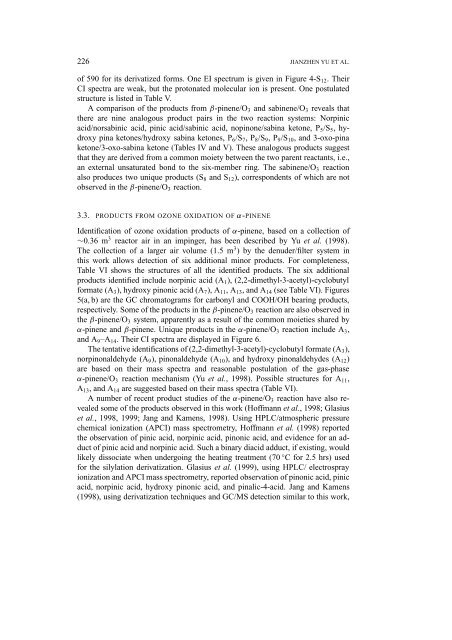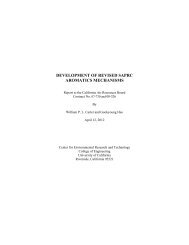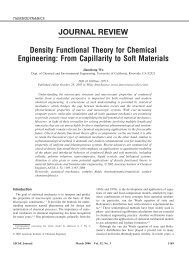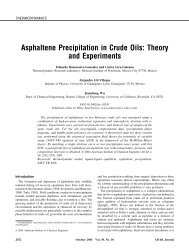Gas-Phase Ozone Oxidation of Monoterpenes: Gaseous and ...
Gas-Phase Ozone Oxidation of Monoterpenes: Gaseous and ...
Gas-Phase Ozone Oxidation of Monoterpenes: Gaseous and ...
You also want an ePaper? Increase the reach of your titles
YUMPU automatically turns print PDFs into web optimized ePapers that Google loves.
226 JIANZHEN YU ET AL.<br />
<strong>of</strong> 590 for its derivatized forms. One EI spectrum is given in Figure 4-S 12 .Their<br />
CI spectra are weak, but the protonated molecular ion is present. One postulated<br />
structure is listed in Table V.<br />
A comparison <strong>of</strong> the products from β-pinene/O 3 <strong>and</strong> sabinene/O 3 reveals that<br />
there are nine analogous product pairs in the two reaction systems: Norpinic<br />
acid/norsabinic acid, pinic acid/sabinic acid, nopinone/sabina ketone, P 5 /S 5 , hydroxy<br />
pina ketones/hydroxy sabina ketones, P 6 /S 7 ,P 8 /S 9 ,P 9 /S 10 , <strong>and</strong> 3-oxo-pina<br />
ketone/3-oxo-sabina ketone (Tables IV <strong>and</strong> V). These analogous products suggest<br />
that they are derived from a common moiety between the two parent reactants, i.e.,<br />
an external unsaturated bond to the six-member ring. The sabinene/O 3 reaction<br />
also produces two unique products (S 8 <strong>and</strong> S 12 ), correspondents <strong>of</strong> which are not<br />
observed in the β-pinene/O 3 reaction.<br />
3.3. PRODUCTS FROM OZONE OXIDATION OF α-PINENE<br />
Identification <strong>of</strong> ozone oxidation products <strong>of</strong> α-pinene, based on a collection <strong>of</strong><br />
∼0.36 m 3 reactor air in an impinger, has been described by Yu et al. (1998).<br />
The collection <strong>of</strong> a larger air volume (1.5 m 3 ) by the denuder/filter system in<br />
this work allows detection <strong>of</strong> six additional minor products. For completeness,<br />
Table VI shows the structures <strong>of</strong> all the identified products. The six additional<br />
products identified include norpinic acid (A 1 ), (2,2-dimethyl-3-acetyl)-cyclobutyl<br />
formate (A 3 ), hydroxy pinonic acid (A 7 ), A 11 ,A 13 ,<strong>and</strong>A 14 (see Table VI). Figures<br />
5(a, b) are the GC chromatograms for carbonyl <strong>and</strong> COOH/OH bearing products,<br />
respectively. Some <strong>of</strong> the products in the β-pinene/O 3 reaction are also observed in<br />
the β-pinene/O 3 system, apparently as a result <strong>of</strong> the common moieties shared by<br />
α-pinene <strong>and</strong> β-pinene. Unique products in the α-pinene/O 3 reaction include A 3 ,<br />
<strong>and</strong> A 9 –A 14 . Their CI spectra are displayed in Figure 6.<br />
The tentative identifications <strong>of</strong> (2,2-dimethyl-3-acetyl)-cyclobutyl formate (A 3 ),<br />
norpinonaldehyde (A 9 ), pinonaldehyde (A 10 ), <strong>and</strong> hydroxy pinonaldehydes (A 12 )<br />
are based on their mass spectra <strong>and</strong> reasonable postulation <strong>of</strong> the gas-phase<br />
α-pinene/O 3 reaction mechanism (Yu et al., 1998). Possible structures for A 11 ,<br />
A 13 ,<strong>and</strong>A 14 are suggested based on their mass spectra (Table VI).<br />
A number <strong>of</strong> recent product studies <strong>of</strong> the α-pinene/O 3 reaction have also revealed<br />
some <strong>of</strong> the products observed in this work (H<strong>of</strong>fmann et al., 1998; Glasius<br />
et al., 1998, 1999; Jang <strong>and</strong> Kamens, 1998). Using HPLC/atmospheric pressure<br />
chemical ionization (APCI) mass spectrometry, H<strong>of</strong>fmann et al. (1998) reported<br />
the observation <strong>of</strong> pinic acid, norpinic acid, pinonic acid, <strong>and</strong> evidence for an adduct<br />
<strong>of</strong> pinic acid <strong>and</strong> norpinic acid. Such a binary diacid adduct, if existing, would<br />
likely dissociate when undergoing the heating treatment (70 ◦ C for 2.5 hrs) used<br />
for the silylation derivatization. Glasius et al. (1999), using HPLC/ electrospray<br />
ionization <strong>and</strong> APCI mass spectrometry, reported observation <strong>of</strong> pinonic acid, pinic<br />
acid, norpinic acid, hydroxy pinonic acid, <strong>and</strong> pinalic-4-acid. Jang <strong>and</strong> Kamens<br />
(1998), using derivatization techniques <strong>and</strong> GC/MS detection similar to this work,
















